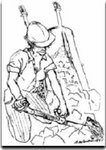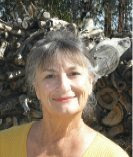
Opal is my passion. I live, breathe, and talk opal. I want to spread the Opal Word. It began with Australian black opal found in Lightning Ridge, New South Wales. On with some facts: The opal fields in Lightning Ridge Australia are believed to have been both an inland sea and/or a series of lagoons, waterways, and swamps. Both salt water and fresh water plants and creatures are opalized in fossil form and are found there by the miners. These fossils were laid down during the Cretaceous Period, about 100-140 million years ago. In 1995, Lightning Ridge was declared the opal capital of the world as per Stephan Aracic's book, "Discover Opal." This respectable looking modern town of unknown population (guess is 6,000 or so) is located approximately 500 miles north of Sydney in the state of NSW, near the Queensland border. Do not be fooled by its respectable new fresh face. Just a couple hundred yards out of town are the old mining "humpies" (camp), a sort of shanty town architecture. Out from Lightning Ridge about 27 km is the new Coocoran Fields. A rush started there in 1988 when my friend John Molyneux found beautiful gem black opal, some of which sold for $6,000 (Australian) per carat field price. The Coocoran is a maze of tracks and a hodge podge of tin huts and caravan trailer mining camps. It is here that the respectability fades: fortunes won and lost, partnership battles, gunshots fired over ratting (the theft of opal out of mine walls while miners are away), old fashioned claim jumping and con artists at work. Perhaps I need to introduce the other me -- the one-half of McCondra who was nicknamed Eskimo Nell by the miners in 1983 when I came to mine, fresh from the Alaska pipeline. Eskimo Nell was, and is, privy to amazing opal finds and became embroiled in many wild and wooly mining experiences. So it is these memories that season my writings on opal with a dash-and-derring-do flavor. That doesn't make it untrue, only less public relations pretty. The mines at the Ridge produce the world's finest gem black opal selling for as much as $20,000 per carat. Magnificent crystal, grey, light, and jelly opal is unearthed along with the black. The opal is found in a nodular form called "nobbies" with some seam opal formations in a sedimentary clay level under sandstone. The nobbies range in size from the head of a pin to twice the size of a man's fist, with walnut-sized nobbies being the most common. The phenomenon known as sunflash sometimes occurs in amber and black nobbies. Amber nobbies are clear, yellow, golden, or beer bottle colored potch and sometimes glassy black centered. Sunflash is mysterious and magnificent to behold. Usually, as the name implies, it manifests in strong sunlight. The rich glassy black opal showing sunflash is considered good trace to the opal miner, and is an affordable specimen to the opal aficionado. The black opal potch (common opal with no color play) varies in shade: charcoal-gray, leady-black, blue-black, black, and glassy black. This blackness forms the black base color upon which, or in which, the color plays. BLACK OPAL shows a play of color in a dark body color. CRYSTAL OPAL is clear with play of color and has no backing. WHITE OPAL shows a play of color in a white body color. The price per carat relates to patterns, brilliance, and actual colors, as does directionality of color, visible inclusions, windows and dead spots.
To see what I do and why I do it go to http://www.parchedearthopals.com/ my site and my son's site http://www.outbackgems.com/ Opal is my passion. I live, breathe, and talk opal.

